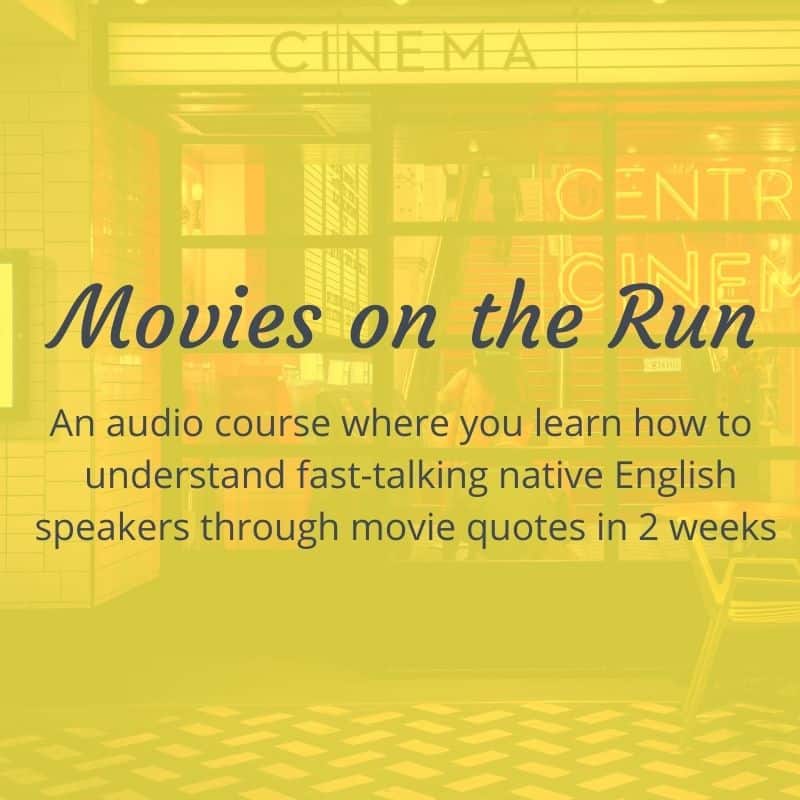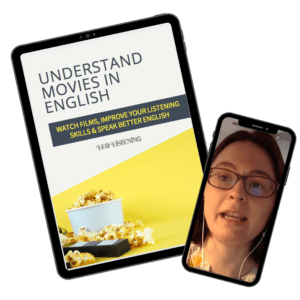
Recap
In the previous post we were talking about the two things that you must do whenever you want to understand anything that you listen to, preferably something that has some kind of written text to go with it like subtitles or a transcript.
First you need to diagnose your problems, and we talked about the ways to do that in last week’s post. The main way is to do dictations, and that’s where you find out what you’re struggling with. The second thing to do is to fix the problems.
We said that, typically in films, you’re going to encounter problems due to unfamiliar cultural references, unfamiliar words, or words that you do know but that sound different in fast, spoken English.
Words That Sound Different In Fast English Speech
In this post we’re focussing on that last situation, with words that you do know, but which sound different because most of the time, that’s the problem that people have. You hear words that you know, but they sound different because of the way sounds join together, or sounds disappear because of the way it sounds when we speak fast.
We’re going to work on a clip from “Never let me go” which I think is quite challenging and we’re going to talk about some of the typical tricky bits. We’re also going to focus on different ways to fix the problems you might have.
Join me for this video walkthrough
Watch the video:
Listen to the post:
“Never Let Me Go” Clip
The clip is from the channel Movie Clips, which I love, and it’s an official channel with movie clips from different films. That really helps because whereas on Youtube sometimes clips disappear, on Movie Clips, it’s official, so all the clips stay on that channel and won’t disappear from one week to the next.
In this clip you’ve got the characters when they’re younger, at the boarding school Hailsham, where they’re protected from the outside world.
It’s quite challenging because we’ve got voices of younger actresses, and often younger people’s voices can be trickier to understand, just because they’ve got a higher-pitched voice. They sound different to adults, and very often when you’re learning English, you don’t really get the chance to hear the voices of children or younger people because most of the time in textbooks they use adult actors to talk. So that definitely makes life a bit trickier.
I’m going to focus mostly on the speech of Miss Lucy, who’s one of the teachers at Hailsham.
A lot of the transcripts and therefore subtitles on movie clips are accurate. They’re not machine-generated automatically by Youtube, but they’re actually checked and corrected. But it’s not true on all the clips. You do have to check.
Unfortunately on this clip we do have subtitles, but they’re machine-generated, so therefore not accurate. That is going to make life a bit difficult, especially if you wanted to work on this clip on your own.
But it’s sufficient for me to show you some of the typical listening difficulties that happen whenever you’re listening to fast spoken English. So we’re not going to worry about it too much for now.
I’ve linked to the clip so that you can go away and listen to it yourself. I always recommend to my students that they take a clip and listen to the whole thing. So they get into the clip by listening to it through once, trying to catch what they can, then expressing how much they understood as a percentage. It’s not 100% accurate, but at least it gives them an idea, and it gives me an idea of how much they’ve understood.
I would encourage you to go away and do that after reading this blog post – go away and watch the whole clip yourself and judge how much you’ve understood using a percentage.

Miss Lucy’s Speech
As I said, I’m going to focus on the speech of Miss Lucy. I’ve pulled up the transcript even though there are mistakes such as “Miss Pissy”, (No, that’s not her name, it’s Miss Lucy!) One cool technique that you can use to start fixing your listening problems is that, on Youtube you can click on a line and that enables you to play that particular line from the clip.
So we’re going to start with this first line from Miss Lucy:
“Why didn’t Tommy get the ball?”
So there are a few difficulties here. The sentence is perfectly simple and normal – why didn’t Tommy get the ball?
One of the reasons it sounds very fast and a little hard to catch is that Miss Lucy drops some of the T sounds. Instead of saying “didn’t”, she says “didn'”. “Why didn’ Tommy”. She also drops the T sound on “get”.
This is the normal situation in English. T sounds are mostly going to disappear, especially at the end of words.
We’ve also got the issue that there are some weak sounds so “the” sounds like “th” Th-ball. That’s typically a word that disappears and sounds like it’s swallowed in speech. In fact even “didn’t” as well, because it’s an auxiliary verb, disappears, and sometimes it can be hard to tell – is she using the negative or the affirmative because the T sound disappears and you’re not quite sure which version it is.
So that’s what’s going on there. There’s a big issue for people learning English when they first hear fast spoken speech, and that’s “where did all the T sounds go?”
“When it bounced over the fence it couldn’t have been far from him.”
There was a lot there. She didn’t say “and it bounced over the fence”, she says “when it bounced”. So again we’ve got some disappearing T sounds. The way she says “it” sounds like “I'”. That’s mostly how this word sounds in English. We rarely say “it” with a nice T sound at the end.
We’ve also got some links here between “and” when it” – “when’i bounced”, and “bounced” and “over” bounced over the fence.
In the last line, the automatic transcript has made an error. Often the errors that you see in the automatic transcripts are really interesting because they show some of the difficulties related to fast connected speech.
So what Miss Lucy says but in contracted form is “it could not have been far”. So she contracts could-not-have-been to couldn’t’ve been.
Contractions in general are hard to catch and this particular one is really difficult, even to catch that it’s a negative. This is the problem that the automatic transcript has had here.
If you’re not used to British accents it can sound a bit weird because we don’t pronounce the R sound at the end of words in general, so you get “fa” instead of “far”. This might sound weird if you’re expecting to hear an R sound
An interesting point here, and this is what the girls do, is that normally we drop the H sound on words like “him” and “he” in the middle of sentences. Here she actually pronounces it – “him”, which is a little unusual, although given that it’s the end of her sentence, sometimes we do emphasise the words at the end a little bit more.
I’ve already talked about “couldn’t’ve”. “Been” is a typical word that gets reduced to “bin”. That makes it hard to catch if you’re expecting to hear the word “been”.
I encourage you to go and watch the rest of the clip, figure out how much you understand, and then you can use this technique as one of the ways to fix your problem. You can replay particular lines on Youtube. You can even search for more examples of words that you find tricky. For example here I highlighted some of the contractions, especially the negative contractions. You could search for more of them.
If I do a search for “didn'” using control find, or command find if you’re on a Mac, it brings up two examples. The clip is quite short, so we’ve only got two examples, which isn’t so helpful.
The issue here is that you can see the lines, which spoils the exercise slightly because you can see everything, plus this transcript has errors.
Using the Youtube transcription can be a really big help. It probably works best if you’re working with a teacher so you can’t see the clip and your teacher is playing the lines to you. That’s easier because you aren’t influenced by the text.
Youtube can work, but it’s maybe not an ideal method if you’re working by yourself.
Other Resources To Help You Understand Fast Speech
I’m going to talk about a couple of other things that you can do instead
Using Youtube means you can get intensive practice on something that you’re finding difficult that you identified at the diagnostic stage. The typical words and sounds that you’re missing or mishearing are the ones that you want to train.
There’s a brilliant website that exists for training those exact problems and it’s called Tube Quizard, by a very talented teacher called Olga Sergeeva, and Tube Quizard works, but only with Youtube videos that have accurate subtitles.
You can either use one of the quizzes from a video that you’ve already got on the site, or you can bring in a video that you want to work on.
If we do a search for “Never let me go film”, – use the word “film” as well or you’ll get other weird things. So it brings up some trailers, which are maybe not ideal.
As I explained, this won’t work with the video that we just worked on because the subtitles were not accurate.
The next best thing is an interview with Sally Hawkins who plays Miss Lucy. This is brilliant because it means that they’ve already created some quizzes on the website around this video. The first video is on contractions. Can you catch contractions such as “I’ll”, “He’d” and so on?
I identified that as a problem in the clip that we’ve just watched.
We’ve also got articles, comparative adjectives etc. Ok, let’s take a look at the contractions one:
“The older guardians are quite sombre, stern figures … because she’s younger and”.
Ok so I jumped the section with the gap to fill in”.
“between … and because she’s younger and closer”
So “she’s” the correct answer here – this will make more sense if you click on the link and look at it yourself.
By doing this quiz, if you’ve identified that contractions are a problem for you, especially with this actress’s accent, you can go in and just focus on catching the contractions. So you’ve diagnosed the problem and now you’re fixing it by working on it intensively.
That’s the whole idea behind Tube Quizard, but the only caveat is that you need to have accurate subtitles.
An alternative to Tube Quizard is a website that I’ve talked about before on this blog called Voscreen. There’s a whole collection of different clips from lots of different films, and you can do a search by grammatical structure. So you could select contractions.
The only thing is, it won’t just bring up one video with one accent and one voice, but lots of different clips from different films that contain the structure that you want to train your ear with. It can be a good idea, but I think it’s better to work on just one video, preferably with one or maybe two speakers so that you don’t have the additional problem of unknown accents or unfamiliar voices. It can work, but I think the lack of consistency can be a bit of a problem.
In this article, we’ve been through how to fix the problems that you’ve diagnosed with a couple of different solutions. So please go and watch the clip, rate your understanding, diagnose your problems and have a go at fixing them!

Fed up of watching movies with subtitles?
Feel nervous before you talk to a native speaker in case you don’t understand them?
“Movies on the Run” is an audio course that teaches you 10 English listening secrets that will help you understand native speakers when they talk fast.
Plus, you discover famous movies and the quotes that have become part of everyday speech and culture so you can fit in better. Find out more about Movies on the Run.

